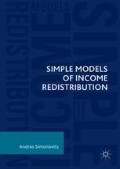Abstract
This chapter deals with optimal child benefits when fertility is endogenous and younger workers raise children and older workers only contribute to financing the child benefits. It is assumed that the wages are heterogeneous and personal income taxes finance only benefits but a basic income for everybody. Earlier models worked with homogeneous wages and assumed that the child benefit is only spent on raising children. Now the raising cost of a child is proportional to the net family income, containing the child benefits. The parent’s consumption becomes a nonlinear function of the fertility, which complicates the analysis but avoids absurdities. The main results is that child benefit is socially optimal if an only if the past fertility rate was less than 2 (1 in our unisex model).
Access this chapter
Tax calculation will be finalised at checkout
Purchases are for personal use only
Preview
Unable to display preview. Download preview PDF.
References
App, P., & Rees, R. (2012). Optimal Taxation, Child Care and Models for Households (Discussion Paper 6823). Bonn: IZA.
Augusztinovics, M. (1989). The Costs of Human Life. Economic Systems Research, 1, 5–26.
Becker, G. S. (1960). An Economic Analysis of Fertility. In R. Esterline (Ed.), Demographic and Economic Change in Developed Countries. Princeton: Princeton University Press.
Becker, G. S. (1991). A Treatise on the Family, an enlarged edition. Cambridge, MA: Harvard University Press.
Becker, G. S., & Barro, R. (1988). A Reformulation of the Economic Theory of Fertility. Quarterly Journal of Economics, 103, 1–25.
Cigno, A. (1986). Fertility and the Tax-Benefit System. Economic Journal, 96, 1035–1051.
Cremer, H., Gahvari, F., & Pestieau, P. (2008). Pensions with Heterogeneous Individuals and Endogenous Fertility. Journal of Population Economics, 21, 961–981.
Fehr, H., Kallweit, M., & Kindermann, F. (2016). Household Formation, Female Labor Supply and Saving. Scandinavian Journal of Economics, 118, 868–911.
Fenge, R., & Meier, R. (2009). Are Family Benefits and Fertility Related Pensions Perfect Substitutes? International Tax and Public Finance, 16, 137–163.
Gábos, A., Gál, R. I., & Kézdi, G. (2009). The Effects of Child-Related Benefits and Pensions on Fertility by Birth-Order. Population Studies: A Journal of Demography, 16, 215–231.
Greenwood, J., Sheshadri, A., & Vandenbroucke, G. (2005). The Baby Boom and Baby Bust. American Economic Review, 95, 183–207.
Haan, P., & Wrohlich, K. (2011). Can Child Care Policy Encourage Employment and Fertility. Labour Economics, 18, 498–512.
Hakim, C. (2003). A New Approach to Explaining Fertility Patterns: Preference Theory. Population and Development Review, 29, 349–374.
Lindbeck, A., Nyberg, S., & Weibull, J. W. (1999). Social Norms and the Welfare State. Quarterly Journal of Economics, 114, 1–35.
Pestieau, P., & Ponthiere, G. (2014). Policy Implications for Changing Longevity. CESifo Economic Studies, 60, 178–212.
Samuelson, P. A. (1958). An Exact Consumption-Loan Model of Interest with or Without the Social Contrivance of Money. Journal of Political Economy, 66, 467–482.
Simonovits, A. (2013). Savings, Child Support, Pensions and Endogenous (and Heterogeneous) Fertility (IE-CERS-HAS Working Paper 35).
Simonovits, A. (2015). Socially Optimal Child-Related Transfers with Endogenous Fertility (IE-CERS-HAS Working Paper 37).
van Groezen, B., Leers, T., & Meijdam, L. (2003). Social Security and Endogenous Fertility: Pensions and Child Benefits as Siamese Twins. Journal of Public Economics, 87, 233–251.
Author information
Authors and Affiliations
Corresponding author
Rights and permissions
Copyright information
© 2018 The Author(s)
About this chapter
Cite this chapter
Simonovits, A. (2018). Optimal Child Benefits and Income Taxes. In: Simple Models of Income Redistribution. Palgrave Macmillan, Cham. https://doi.org/10.1007/978-3-319-72502-4_10
Download citation
DOI: https://doi.org/10.1007/978-3-319-72502-4_10
Published:
Publisher Name: Palgrave Macmillan, Cham
Print ISBN: 978-3-319-72501-7
Online ISBN: 978-3-319-72502-4
eBook Packages: Economics and FinanceEconomics and Finance (R0)

